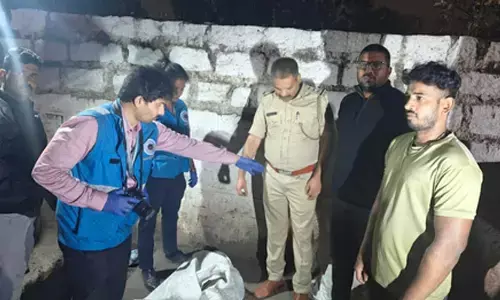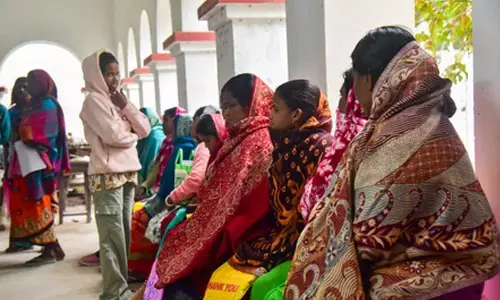WARP AND WEFT-3: Demand for dhurries sees a big dip; weavers in doldrums

- Warangal has held a significant position as a hub for crafting durries, imbued with a distinctive local essence
- Over time, this practice became an integral source of livelihood for the local populace, spanning generations for well over a century
- Telangana’s second largest city, Warangal is famous for its unique handmade durries
- The patterns on these weaves are geometric, angular, and colourful horizontal stripes
“Warangal Dhurries were once sought after in several countries, including the United States of America (USA), Japan, Spain, and Italy. Regrettably, these international avenues have diminished over time. Domestically, these dhurries found their way to various destinations within India, such as Delhi, Panipat, and Sitapur. - Kuchana Lakshminarayana, Usha Kiran Handlooms, Kothawada
“In the vicinity of Warangal district, approximately 20-25 societies are dedicated to the craft of durrie making. Notably, within the district itself, operational units are established in Kothewada, Deshaipet, and Mattewada. Currently, we supply these durries to various tribal, social welfare, and BC welfare hostels. While a ray of hope gleams among the weavers, there exists a need for intensified governmental initiatives to safeguard this handicraft. - Yelugam Sambaiah, President, Kshtranji Chenetha Sahakara Sangam
Hyderabad: Warangal Dhurries, once a significant contributor to Telangana’s handloom exports, have experienced a steep decline, leaving the weavers without any avenues for marketing their products. Warangal has held a significant position as a hub for crafting durries, imbued with a distinctive local essence. The legacy of durrie production in Warangal traces its origins to the Mughal period, when artists and artisans accompanying the Mughal army’s expansion into the Deccan region turned their skills towards crafting carpets.
Over time, this practice became an integral source of livelihood for the local populace, spanning generations for well over a century. This labor-intensive, rural-based cottage industry continues to thrive although with very meagre resources.
Telangana’s second largest city, Warangal is famous for its unique handmade durries. These rugs are well known for their natural colours and materials, such as cotton, jute, and wool. Durries are woven on pit and frame looms using treadles with weft interlocking technique. The patterns on these weaves are geometric, angular, and colourful horizontal stripes. Mostly, primary colours are used in combination with neutral colours. This woven craft was awarded geographical indication (GI 2018) tag from the Geographical Indication Registry in Chennai.
A recent innovation embraced by the local weavers involves the fusion of tie-dyed ikat techniques with hand-painted or block-printed kalamkari designs for dhurries, a creative adjustment that serves to economize time and energy.
Speaking to The Hans India, Kuchana Lakshminarayana, Usha Kiran Handlooms, Kothawada, said, “Warangal Dhurries were once sought after in several countries, including the United States of America (USA), Japan, Spain, and Italy. Regrettably, these international avenues have diminished over time. Domestically, these dhurries found their way to various destinations within India, such as Delhi, Panipat, and Sitapur. Weavers from these locations often journeyed to Warangal to acquire the craft, subsequently establishing their own production units. While there is a glimmer of optimism due to the Telangana State Cooperative Society (TSCO) procuring our products, the income earned by the artisans involved in crafting these goods remains notably meagre.”
Presently, a mere 5,000 families persist in preserving this traditional craft. In 1995, the World Trade Organisation (WTO) introduced quotas and additional non-tariff constraints on handloom products, adversely impacting the export of Warangal dhurries, he added.
Women play a vital role in the durrie-making process, contributing actively alongside men to secure a modest livelihood. While men primarily handle the operation of the pit loom, various other tasks are expertly executed by women. They engage in tasks ranging from yarn spinning to the operation of the frame loom, showcasing remarkable efficiency and skill.
A captivating historical anecdote recounts that during the renowned Great Exhibition of 1851 in London, Warangal contributed two splendid silk-woven carpets. These exceptional creations garnered a position of honor among a staggering array of over one lakh exhibits, which notably included the legendary Koh-i-Noor diamond.
Yelagam Sambaiah, President, Kshtranji ChenethaSahakara Sangam, says, “In the vicinity of Warangal district, approximately 20-25 societies are dedicated to the craft of durrie making. Notably, within the district itself, operational units are established in Kothewada, Deshaipet, and Mattewada. Currently, we supply these durries to various tribal, social welfare, and BC welfare hostels. While a ray of hope gleams among the weavers, there exists a need for intensified governmental initiatives to safeguard this handicraft. Such efforts would empower artisans in their endeavor to conserve this cherished craft.”
















